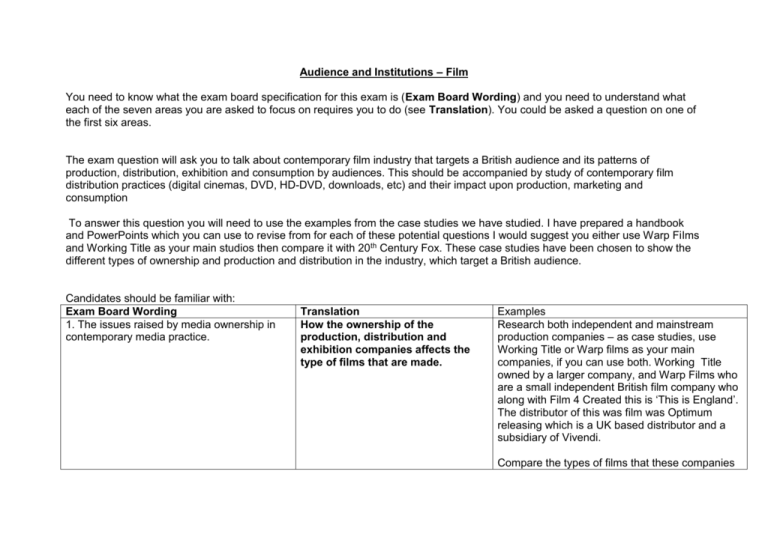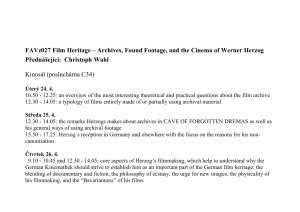how to answer your question for film
advertisement

Audience and Institutions – Film You need to know what the exam board specification for this exam is (Exam Board Wording) and you need to understand what each of the seven areas you are asked to focus on requires you to do (see Translation). You could be asked a question on one of the first six areas. The exam question will ask you to talk about contemporary film industry that targets a British audience and its patterns of production, distribution, exhibition and consumption by audiences. This should be accompanied by study of contemporary film distribution practices (digital cinemas, DVD, HD-DVD, downloads, etc) and their impact upon production, marketing and consumption To answer this question you will need to use the examples from the case studies we have studied. I have prepared a handbook and PowerPoints which you can use to revise from for each of these potential questions I would suggest you either use Warp Films and Working Title as your main studios then compare it with 20th Century Fox. These case studies have been chosen to show the different types of ownership and production and distribution in the industry, which target a British audience. Candidates should be familiar with: Exam Board Wording 1. The issues raised by media ownership in contemporary media practice. Translation How the ownership of the production, distribution and exhibition companies affects the type of films that are made. Examples Research both independent and mainstream production companies – as case studies, use Working Title or Warp films as your main companies, if you can use both. Working Title owned by a larger company, and Warp Films who are a small independent British film company who along with Film 4 Created this is ‘This is England’. The distributor of this was film was Optimum releasing which is a UK based distributor and a subsidiary of Vivendi. Compare the types of films that these companies 2. The importance of cross media convergence and synergy in production, distribution and marketing. Understand how all aspects of the media (websites, newspapers, television etc) are used to market a film and show you understand how companies work together to produce and distribute films. 3. The technologies that have been produced in recent years at the levels of production, distribution, marketing and exchange. Show you are aware of how new technology has been used to improve the making, distributing, marketing and exhibition on film. 4. The significance of the proliferation of hardware and content for institutions and audiences. Show you understand how the increase and improvements made in technology are affecting the ways that films are made and distributed today. Also, be able to assess how technological improvements have impacted the viewing experience, at home and in the cinema. Understand how new technologies can combine to produce, market, 5. The importance of technological convergence for institutions and audiences. make and how they make sure they reach their target audience. Look at Twentieth Century Fox’s role in distributing Avatar remember a different studio’s produced this and it wasn’t the first 3d film Research independent and mainstream production companies – Twentieth Century Fox (owned by News Corps) and Working Title or Warp films – compare how their films are marketed through other aspects of the media. Find out who distributes their films. Look at specific example. As supporting material you should also look at films like ‘This is England’, (Warp Film) and ‘The Boat That Rocked’, ‘A Serious Man’ (Working Title) Find out about filming in HD, SPFX and how they are added at the editing stage of film production, how the internet influences the ways films are marketed and distributed, digital distribution of film (research DSN -Digital Screen Network) and digital exhibition of film. Refer to case study. You need to be able to explore how the affordability of new technology has impacted on the making, distribution and exhibition of film. The DSN is relevant to this area too – how has it improved our access to film? What about Bluray and the affordability of DVDs? Piracy? Refer to case study. Information researched for bullet point 3 is relevant here too. Information from bullet point 3 and 4 relevant here too but you need to have specific examples of distribute and exhibit a film successfully. 6. The issues raised in the targeting of national and local audiences (specifically British) by international or global institutions 7. The ways in which the candidates’ own experience of media consumption illustrate wider patterns and trends in audience behaviour. how technologies can combine to reach a target audience (Eg, ‘The Boat that Rocked’ – soundtrack was advertised on mp3.com. Vivendi own Universal and mp3.com. ‘This is England’ Greenroom digital (marketing agency) approached Britfilm.tv to launch a ‘site take-over’ to market the film to target audience. ) Show you know how international ‘Working Title’ is owned by ‘Universal’, why is it in and global institutions target a Universal’s interest to have a subsidiary such as national and local British audience. WT. Compare WT’s films to ‘blockbusting’ movies such as ‘Avatar’. How do films, such as this, target such massive audiences? Include reference to how your own You will not be asked a question on this experience of the media shows how however you will need to incorporate this an audience may behave. element in each one of the six potential areas above. Types of questions they may ask • Discuss the issues raised by an institution’s need to target specific audiences within a media industry which you have studied • Discuss the ways in which media products are produced and distributed to audiences? • Media production is dominated by global institutions, which sell their products and services to national audiences. To what extent do you agree with this statement • What significance does the continuing development of digital media technology have for media institutions and audiences? Regardless of the question you must discuss such key concepts: Audience, Production, Distribution, Exhibition and Exchange. • Remember to also use and apply concepts such as Technological Convergence, Synergies, Media Convergence (for media ownership) etc. Mark scheme • Explanation/analysis/argument (16-20 marks) • Shows excellent understanding of the task • Excellent knowledge and understanding of institutional/audience practices – factual knowledge is relevant and accurate • A clear and developed argument, substantiated by detailed reference to case study material • Clearly relevant to set question • • Use of examples (16-20 marks) • Offers frequent evidence from case study material – award marks to reflect the range and appropriateness of examples • Offers a full range of examples from case study and own experience • Offers examples which are clearly relevant to the set question • Use of terminology (8-10 marks) How to answer the question Explanation Here you must explain your answer, using you case studies, remember compare and contrast is also high level thinking. Look at handbook for key points. Evidence Here you must use evidence to support your point from your case study i.e. how Warp distributes films compare and contrast or the different audiences etc. Argument i.e. Analyse and provide an argument using explanation, evidence from your case studies, this should also be a compare and contrast Terminology Synergy Convergence Conglomerate Tent pole Above the line Below the line Read handbook for terminology







